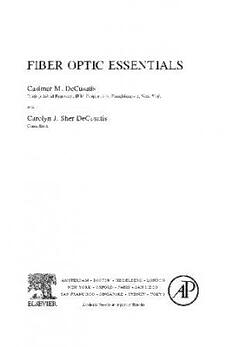
Fiber Optic Essentials PDF
Preview Fiber Optic Essentials
FIBER OPTIC ESSENTIALS FIBER OPTIC ESSENTIALS Casimer M. DeCusatis DistinguishedEngineer,IBMCorporation,Poughkeepsie,NewYork and Carolyn J. Sher DeCusatis Consultant AMSTERDAM•BOSTON•HEIDELBERG•LONDON NEWYORK•OXFORD•PARIS•SANDIEGO SANFRANCISCO•SINGAPORE•SYDNEY•TOKYO AcademicPressisanimprintofElsevier AcademicPressisanimprintofElsevier 30CorporateDrive,Suite400,Burlington,MA01803,USA 525BStreet,Suite1900,SanDiego,California92101-4495,USA 84Theobald’sRoad,LondonWC1X8RR,UK Thisbookisprintedonacid-freepaper. Copyright©2006,ElsevierInc.Allrightsreserved. Nopartofthispublicationmaybereproducedortransmittedinanyformorbyany means,electronicormechanical,includingphotocopy,recording,oranyinformation storageandretrievalsystem,withoutpermissioninwritingfromthepublisher. PermissionsmaybesoughtdirectlyfromElsevier’sScience&TechnologyRights DepartmentinOxford,UK:phone:(+44)1865843830,fax:(+44)1865853333, E-mail:[email protected] viatheElsevierhomepage(http://elsevier.com),byselecting “CustomerSupport”andthen“ObtainingPermissions.” LibraryofCongressCataloging-in-PublicationData ApplicationSubmitted BritishLibraryCataloguinginPublicationData AcataloguerecordforthisbookisavailablefromtheBritishLibrary ISBN13:978-0-12-208431-7 ISBN10:0-12-208431-4 ForinformationonallElsevierAcademicPresspublications visitourWebsiteatwww.books.elsevier.com PrintedintheUnitedStatesofAmerica 05 06 07 08 09 10 9 8 7 6 5 4 3 2 1 Working together to grow libraries in developing countries www.elsevier.com | www.bookaid.org | www.sabre.org Contents Preface ix Chapter 1 Fiber, Cables, and Connectors 1 1.1 OpticalFiberPrinciples 4 1.2 BasicTerminology 13 1.3 Single-ModeFiber 16 1.4 MultimodeFiber 19 1.5 FiberBraggGratings(FBGs) 20 1.6 PlasticOpticalFiber 21 1.7 Cables 23 References 26 Chapter 2 Transmitters 29 2.1 BasicTransmitterSpecificationTerminology 30 2.1.1 LaserSafety 32 2.2 LightEmittingDiodes 34 2.3 Lasers 39 2.3.1 DoubleHeterostructureLaserDiodes 43 2.3.2 QuantumWell(QW)andStrainedLayer(SL)Quantum WellLasers 44 2.3.3 DistributedBraggReflector(DBR)andDistributed Feedback(DFB)Lasers 45 2.3.4 VerticalCavitySurface-EmittingLasers 47 2.4 Modulators 48 2.4.1 LithiumNiobateModulators 50 2.4.2 ElectroabsorptionModulators 51 2.4.3 ElectroOpticandElectrorefractiveSemiconductor Modulators 52 References 53 v vi Contents Chapter 3 Detectors and Receivers 55 3.1 BasicDetectorSpecificationTerminology 56 3.2 PNPhotodiode 62 3.3 PINPhotodiode 65 3.4 OtherDetectors 73 3.4.1 AvalanchePhotodiode 74 3.4.2 PhotodiodeArray 76 3.4.3 Schottky-BarrierPhotodiodes 78 3.4.4 Metal-Semiconductor-Metal(MSM)Detectors 79 3.4.5 Resonant-CavityEnhancedPhotodetectors(RECAP) 82 3.4.6 InterferometricSensors 83 3.5 Noise 85 3.5.1 ShotNoise 88 3.5.2 ThermalNoise 88 3.5.3 OtherNoiseSources 89 3.5.4 Signal-to-NoiseRatio 90 References 91 Chapter 4 Fiber Optic Link Design 93 4.1 FiguresofMerit 93 4.2 LinkBudgetAnalysis 98 4.2.1 InstallationLoss 98 4.2.2 TransmissionLoss 99 4.2.3 Attenuationvs.Wavelength 99 4.2.4 ConnectorandSpliceLoss 99 4.3 OpticalPowerPenalties 100 4.3.1 Dispersion 100 4.3.2 ModePartitionNoise 103 4.3.3 RelativeIntensityNoise 104 4.3.4 Jitter 105 4.3.5 ModalNoise 106 4.3.6 RadiationInducedLoss 107 References 108 Chapter 5 Repeaters and Optical Amplifiers 111 5.1 Repeaters 114 5.2 OpticalAmplifiers 115 5.2.1 RareEarthDopedOpticalFiberAmplifiers 115 5.2.2 SemiconductorAmplifiers 119 5.2.3 NonlinearEffectsandOpticalAmplifiersforWDM 120 References 124 Chapter 6 Wavelength Multiplexing 125 6.1 WDMDesignConsiderations 130 6.2 NetworkTopologies 135 Contents vii 6.3 Latency 138 6.4 ProtectionandRestoration 143 6.5 NetworkManagement 145 References 146 Chapter 7 Fiber Optic Communication Standards 149 7.1 WhyDoWeNeedStandards? 149 7.2 ESCON/SBCON 154 7.3 FiberDistributedDataInterface 155 7.4 FibreChannelStandard 157 7.5 ATM/SONET 158 7.6 GigabitEthernet 160 7.7 InfiniBand 162 References 163 Chapter 8 Fabrication and Measurement 165 8.1 FabricationTechniques 165 8.1.1 FiberDrawing:LiquidPhaseMethods 166 8.1.2 FiberDrawing:ChemicalVaporDeposition 167 8.2 FiberBraggGratings 170 8.3 SemiconductorDeviceFabrication 171 8.4 MeasurementEquipment 174 8.4.1 FiberOpticPowerMeter 174 8.4.2 OpticalTimeDomainReflectometer(OTDR) 175 8.4.3 BitErrorRateTest(BERT) 176 8.4.4 DigitalSamplingOscilloscope 177 References 179 Chapter 9 Medical Applications 181 9.1 Endoscopes 182 9.1.1 RigidEndoscopes 185 9.1.2 TheClinicalEnvironment 186 9.2 LaserFibers 186 9.2.1 Applications 188 9.3 Illumination 190 9.4 Biosensors 191 References 193 Chapter10 Fiber Facts 195 10.1 BasicInformation 195 10.1.1 Moore’s“Law”andOpticalDataCommunication 196 10.1.2 InternetTraffic 197 10.1.3 Capacityvs.Cost 197 10.2 DisasterRecoveryFacts 198 viii Contents 10.3 FiberforLightingandIllumination 200 10.4 UnusualApplicationsandFutureDevelopments 203 References 204 Chapter11 Fiber Optic Timeline 207 11.1 BasicKnowledgeTimeline 208 11.2 TimelineforSelectedOpticalDataCommunicationsMilestones 211 11.3 TimelineforFiberOpticMilestonesinMedicalApplications 213 References 216 AppendixA Glossary 219 AppendixB Acronyms and Initials 241 AppendixC Measurement Conversion Tables 261 Index 263 Preface The development of optical fiber technology for communication net- works, medical applications, and other areas represents a unique conflu- ence of the physics, electronics, and mechanical engineering disciplines. Itshistoryextendsbacktotheearliestusesoflightandmirrorsbyancient civilizations, including many false starts (the so-called “lost generation” described in Jeff Hect’s book, City of Light), under-appreciated discov- eries, and success stories. Today, the amount of optical fiber installed worldwide is equivalent to over 70 round trips to the moon, and this technology has matured to serve as the backbone of the Internet, the global telecommunications infrastructure, and the basis of exciting new developments in illumination, imaging, sensing, and control that were scarcely imagined when the laser was first developed in the early 1960s. As this field has grown, many new practitioners with an established background in physics or electrical engineering have begun to work in some branch of the optical fiber field. Service technicians accustomed to working with copper cables have been asked to retrain themselves and understand the basics of optical cable installation. There are a growing number of non-traditional workers, including technical marketers, patent lawyers, and others who are attempting to transition into this area. And of course, many new students have begun to study this field as well. Understanding the fundamentals of fiber optics is essential for both the application designer and the basic researcher, and there are many good comprehensive references available, some of which extend to multiple volumes with thousands of pages. Clearly, entire books can and have been written on the topics of lasers, fiber manufacturing, and related ix
